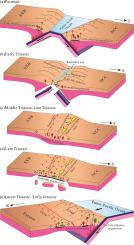当前位置:
X-MOL 学术
›
Gondwana Res.
›
论文详情
Our official English website, www.x-mol.net, welcomes your
feedback! (Note: you will need to create a separate account there.)
A tectonic transition from closure of the Paleo-Asian ocean to subduction of the Paleo-Pacific Plate: Insights from early Mesozoic igneous rocks in eastern Jilin Province, NE China
Gondwana Research ( IF 7.2 ) Pub Date : 2020-05-01 , DOI: 10.1016/j.gr.2020.05.001 Qingbin Guan , Zhenghong Liu , Yongjiang Liu , Sanzhong Li , Shijie Wang , Zhaoxu Chen , Cao Zhang
Gondwana Research ( IF 7.2 ) Pub Date : 2020-05-01 , DOI: 10.1016/j.gr.2020.05.001 Qingbin Guan , Zhenghong Liu , Yongjiang Liu , Sanzhong Li , Shijie Wang , Zhaoxu Chen , Cao Zhang

|
Abstract The timing of tectonic transition from the Paleo-Asian oceanic regime to the Paleo-Pacific regime in the easternmost Central Asian Orogenic Belt remains controversial. To constrain the event, we present new zircon U-Pb ages, Hf isotopic compositions, and whole-rock major- and trace-element data for early Mesozoic igneous rocks from eastern Jilin Province, NE China. These new ages, together with existing age data, indicate that early Mesozoic magmatism in the Kaiyuan–Yanji area can be subdivided into four stages: Early Triassic (ca 250 Ma), Early–Middle Triassic (249–235 Ma), Late Triassic (229–208 Ma) and latest Triassic to Early Jurassic (207–175 Ma). The Early Triassic igneous rocks constitute a bimodal igneous rock association that formed in an extensional environment caused by break-off of the subducting slab during final closure of the Paleo-Asian Ocean. The Early–Middle Triassic magmatism is dominated by adakitic granitoids whose primary magmas were derived from partial melting of thickened mafic lower crust, suggesting that the North China Craton and Songliao–Xilinhot Block were still undergoing collisional orogenesis at 249–235 Ma. The Late Triassic igneous rocks comprise a typical bimodal association of rocks in an E–W-trending belt, formed in a post-orogenic extensional environment related to final closure of the Paleo-Asian Ocean. The latest Triassic to Early Jurassic igneous rocks have calc-alkaline characteristics, were emplaced as a NE–SW-trending belt parallel to the eastern margin of Eurasia, and formed in an active continental margin setting associated with initial subduction of the Paleo-Pacific Plate. We conclude that the tectonic transition between the Paleo-Asian and the Paleo-Pacific regimes took place during the latest Triassic.
更新日期:2020-05-01











































 京公网安备 11010802027423号
京公网安备 11010802027423号